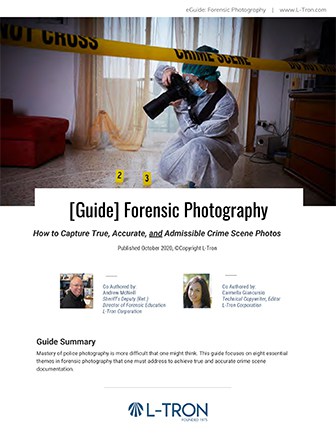How to Capture True, Accurate, and Admissible Crime Scene Photos
Co Authored by: Andrew McNeill and Carmella Giancursio

Guide Summary:
“Forensic photography is not snapshot photography.” – Andrew McNeill
This Guide is meant for investigators & forensic personnel looking to preserving a shot in its original, true & accurate form. More specifically, this Guide is meant for forensic photographers, who must do everything in their power to preserve a scene and document evidence exactly as it was originally found, with no room for interpretation.
Mastery of police photography is more difficult that one might think. This guide focuses on eight essential themes in forensic photography that one must address to achieve true and accurate crime scene documentation.
This guide contains 9 Chapters and 23 pages and is a great resource for those interested in forensic photography.
At L-Tron, our mission is to educate and give back by sharing knowledge. We create educational content from the expertise of our team of engineers, retired Law Enforcement, developers and client success managers.
We believe knowledge is power and we want to give that knowledge to anyone who might benefit from it.
TOPICS COVERED
Camera Selection
There are multiple cameras and styles that can be used to document a crime scene. In this guide, we will discuss DSLR camera, small point-and-shoot cameras and spherical systems. This guide also covers sensor size and resolution to help select a DSLR camera for purchase.
Camera Mode
In this chapter, learn the three camera modes to choose from: auto mode, manual mode, and priority mode. Review each mode and see which are most recommended for crime scene photography.
Camera Exposure Controls
To take a good photo, you must understand how your camera interacts with light and how light affects each photograph you will take. Exposure in forensic photography is critical. This guide will cover aperture, shutter speed, ISO and HDR. If these terms are new for you, no worries – they are all explained in this guide.
Metering Modes
Crime scenes occur day, night, indoors, outdoors and in all sorts of weather. Light meter settings are an important piece for getting proper exposure to accurately capture your scene. This guide covers matrix metering, center-weighted average metering, spot metering, and exposure techniques to pair with matrix metering.
Flash Photography
Although we encourage you to rely on natural lighting from your crime scene environment and manually setting ISO, shutter speed and aperture, there are some situations that will require a flash. This guide discusses the two types of flashes: on-camera flash and off-camera flash. Hear why off-camera flash is highly advantageous for most types of forensic photography and how to use it properly.
Color & White Balance
In this chapter, we will discuss the importance of color and white balance. The type of light in your crime scene will affect the appearance of color or color temperature in your crime scene photos. Learn tips for proper color and white balance settings.
Camera Lenses
There are many different types of lenses and they all have different purposes but they all affect the depiction of distance. The last thing you want is your photo to be deemed not true and accurate because your distance is distorted. This guide covers focal length, lens speed, normal lenses, wide-angle lenses, telephoto lenses, and zoom lenses.
Order of Photography
As a crime scene photographer, you are responsible for capturing and documenting the entire scene including all details, distances, and spatial relationships. This chapter discusses how you can document the scene through overall photography, midrange photographs, and close-up photographs.
Fill out the form below to download ‘Your Guide to Forensic Photography, How to Capture True, Accurate, and Admissible Crime Scene Photos.’
Once you fill out the form, you’ll receive a download link right away.
Just follow these steps:
1. Fill out the form to download
2. You will receive a download link to download the guide via email
3. You can open the PDF directly on your PC, tablet or cell phone
This Forensic Photography eguide is a PDF so you are able to view it on any device.